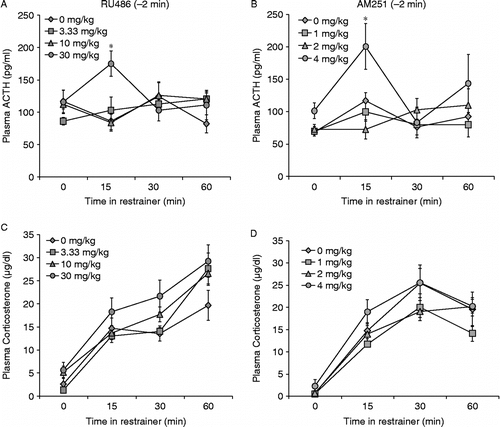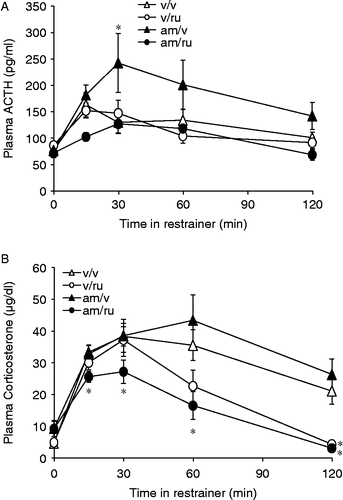Figures & data
Figure 1. RU28362 injected i.p. 2 min before the onset of restraint blunted the hormonal responses to restraint stress. All three doses blunted ACTH 15 min following the onset of restraint (A). There was no difference in corticosterone secretion until 60 min into the restraint period, when plasma corticosterone values in rats that received 75 and 150 μg/kg RU28362 returned to baseline levels (B). Values are group mean + SEM; n = 5–10 per group. *p < 0.05 vs. other group (A) or groups (B).

Figure 2. RU486 and AM251 acted rapidly to increase the ACTH response to restraint stress. Fifteen minutes after the onset of restraint, rats that received RU486 i.p. (30 mg/kg) 2 min before the onset of restraint had significantly higher plasma ACTH values than those treated with 0, 3.33, or 10 mg/kg (A). There was no significant effect of RU486 on stress-induced corticosterone secretion (C). 4 mg/kg AM251 administered i.p. 2 min before the onset of restraint stress caused increased ACTH concentration at the initiation of restraint (2 min after injection) and 15 min into the restraint period (B), but did not alter stress-induced corticosterone secretion (D). Values are group mean + SEM; n = 5–8 per group. *p < 0.05 vs. other groups.

Figure 3. AM251 injected 1 h before the onset of restraint stress alters hormonal responses. Four mg/kg AM251 injected 1 h before restraint initially caused a blunted ACTH response to restraint at 30 min. After 120 min rats that received 4 mg/kg AM251 had increased levels of plasma ACTH, significantly higher than vehicle treated controls (A). Two mg/kg AM251 augmented stress-induced ACTH release at 60 and 120 min after the initiation of restraint (A), and produced significantly higher corticosterone levels compared to vehicle treated controls 60 min following the onset of restraint (B). Values are group mean + SEM; n = 5 per group. *p < 0.05 vs. other groups.

Figure 4. Two mg/kg AM251 injected 60 min before 150 μg/kg RU28362, 2 min before the onset of restraint, produced blunted hormonal responses to restraint stress. Rats that received the combination of AM251/RU28362 showed lower plasma ACTH values at 15 min following the onset of restraint and significantly lower values at 120 min (A). AM251 administered 1 h before RU28362 administration and 62 min before the onset of restraint produced consistently lower stress-induced plasma corticosterone concentrations from 15 to 120 min into the restraint period. RU28362 alone produced significantly blunted corticosterone levels only 120 min following the onset of restraint (B). Values are group mean + SEM; n = 17–20 per group. *p < 0.05 vs. other groups.
